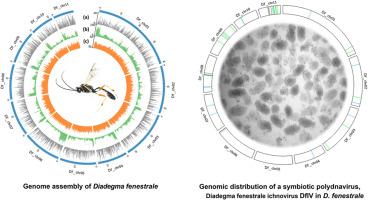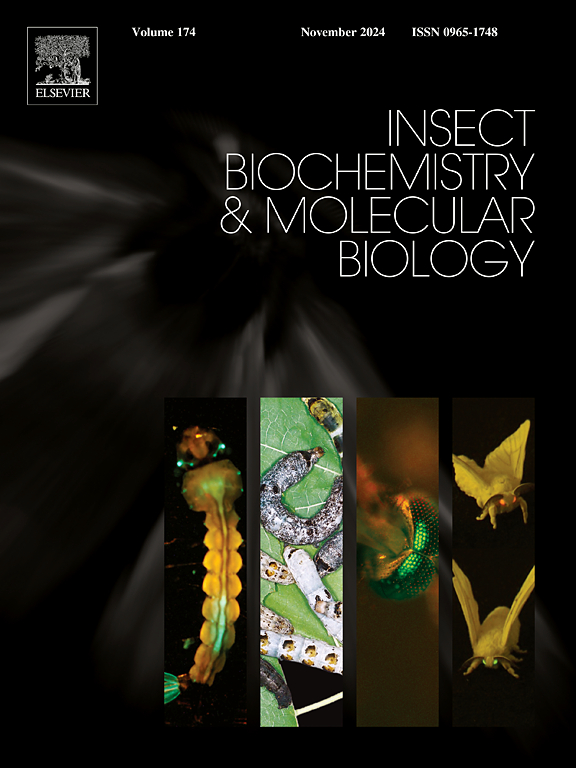姬蜂(膜翅目:姬蜂科)基因组组装及其共生病毒DfIV基因组整合
IF 3.7
2区 农林科学
Q2 BIOCHEMISTRY & MOLECULAR BIOLOGY
引用次数: 0
摘要
窗角斑姬蜂是一种具有生态和农业意义的寄生蜂,具有调节害虫种群的作用。然而,有限的基因组资源阻碍了对其生物学和共生相互作用的深入了解。本研究利用纳米孔和Illumina测序技术,建立了fenestrale的染色体水平基因组组装。组装的221.1 Mb基因组包含68个支架,其中11个位于染色体水平,具有较高的完整性,BUSCO完整性评分为99.6%。共预测了13544个蛋白质编码基因,BUSCO评估表明基因集的完整性为97.5%(单拷贝:96.8%,重复:0.7%),片段化为0.7%,缺失基因为1.8%。与近亲膜翅目昆虫的比较基因组分析为基因组进化提供了新的见解,包括基因家族扩展、收缩模式和染色体重排。此外,本研究还检测了DfIV,一种与雌蜂D. fenestrale相关的共生病毒,鉴定了整合到宿主基因组中的62个基因组片段。大多数片段出现在一个或两个拷贝中,而四个片段出现在三个拷贝中,这表明病毒与宿主基因组之间存在动态相互作用,可能影响基因调控和染色体稳定性。该研究提供了一个全面的基因组资源,增强了我们对其基因组结构、进化动力学和功能适应的理解。这些发现有助于对拟寄生蜂和共生病毒-宿主相互作用的更广泛研究,对生物害虫防治和进化生物学具有重要意义。本文章由计算机程序翻译,如有差异,请以英文原文为准。

Genome assembly of Diadegma fenestrale (Hymenoptera: Ichneumonidae), and genome integration of its symbiotic virus, DfIV
Diadegma fenestrale is a parasitic wasp of ecological and agricultural significance, regulating pest populations. However, limited genomic resources have hindered a deeper understanding of its biology and symbiotic interactions. This study presents a chromosome-level genome assembly of D. fenestrale using Nanopore and Illumina sequencing. The assembled 221.1 Mb genome comprises 68 scaffolds, including 11 at the chromosomal level, and exhibits high completeness with a BUSCO completeness score of 99.6 %. A total of 13,544 protein-coding genes were predicted, with BUSCO assessment of the gene set indicating 97.5 % completeness (single-copy: 96.8 %, duplicated: 0.7 %), 0.7 % fragmented, and 1.8 % missing genes. Comparative genomic analysis with closely related hymenopteran species provides new insights into genome evolution, including gene family expansion, contraction patterns, and chromosomal rearrangements. Additionally, this study examines DfIV, a symbiotic virus associated with D. fenestrale, identifying 62 genome segments integrated into the host genome. Most segments are present in one or two copies, while four segments exhibit three copies, suggesting a dynamic interaction between the virus and the host genome that may influence gene regulation and chromosomal stability. This study provides a comprehensive genomic resource for D. fenestrale, enhancing our understanding of its genomic architecture, evolutionary dynamics, and functional adaptations. The findings contribute to broader research on parasitoid wasps, and symbiotic virus-host interactions, with implications for biological pest control and evolutionary biology.
求助全文
通过发布文献求助,成功后即可免费获取论文全文。
去求助
来源期刊
CiteScore
7.40
自引率
5.30%
发文量
105
审稿时长
40 days
期刊介绍:
This international journal publishes original contributions and mini-reviews in the fields of insect biochemistry and insect molecular biology. Main areas of interest are neurochemistry, hormone and pheromone biochemistry, enzymes and metabolism, hormone action and gene regulation, gene characterization and structure, pharmacology, immunology and cell and tissue culture. Papers on the biochemistry and molecular biology of other groups of arthropods are published if of general interest to the readership. Technique papers will be considered for publication if they significantly advance the field of insect biochemistry and molecular biology in the opinion of the Editors and Editorial Board.

 求助内容:
求助内容: 应助结果提醒方式:
应助结果提醒方式:


